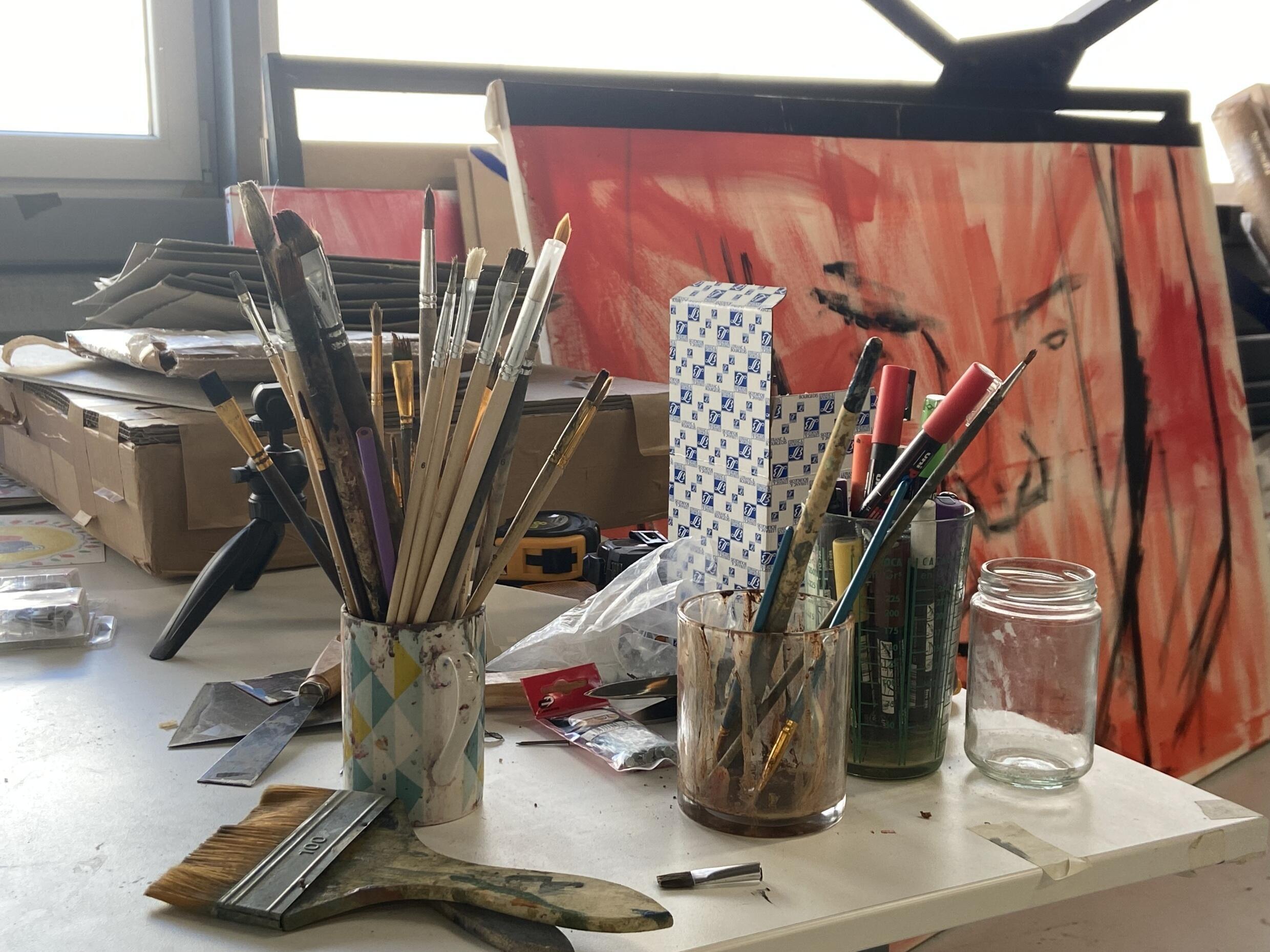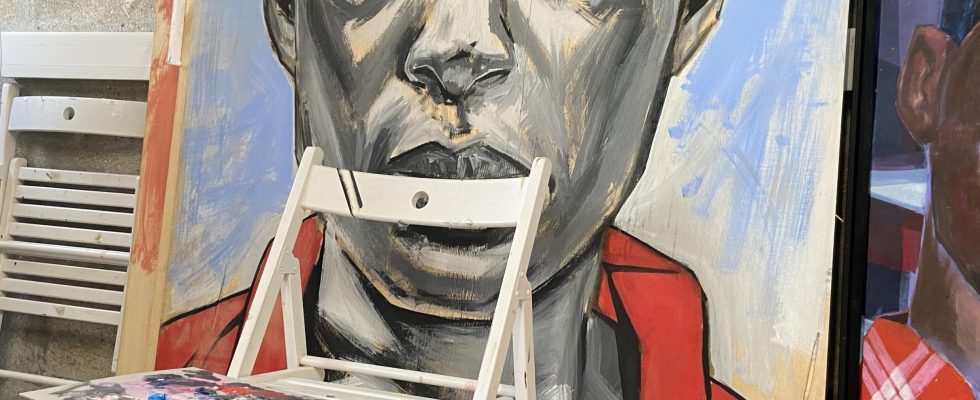Baye-Dam Cissé, better known under the pseudonym Rakajoo, alternates between punches and brushstrokes. While he has just closed his first personal exhibition at the Palais de Tokyo, this self-taught half-boxer, half-painter wants to add sound to the “ Afropeanness » and people from immigrant backgrounds, still too under-represented in the art world.
Upon entering his workshop in Choisy-le-roi, it was first of all the cold that hit us. Rakajoo hasn’t set foot there for several days. His brushes are clean and the paint has dried on his palette, abandoned on a chair along the way. Too busy working on his first comic: Between the ropes (Casterman, October 2024), he only made a detour there to store the paintings from his exhibition “Ceinture Nwar”, which left the premises of the Palais de Tokyo in January.
Since then, around ten large canvases have been piled up in a corner of the room. Here and there, blue makes the paintings thrill: it contrasts with the outlined face of the painter in his self-portrait, illuminates the outfit of his deceased mother, enhances the cheekbones of one of his characters. Rakajoo, whose real name is Baye-Dam Cissé, spreads more than paint on their surface. He depicts memories of the Goutte d’Or district where he grew up, scenes from the Aubervilliers boxing club where he exercises, references to Dragon Ball Z or to Senegal, the country of his ancestors. “ It is a mixture without any real chronology of all the universes in which I have been immersed and which define my life journey. », summarizes Rakajoo, red checkered jacket buttoned up to the neck.
A ” caged bird »
Her ” the course of life “, it was first of all his meeting at the age of 9 with the portrait painters who abound in the Butte-Montmartre. There he discovered art and became passionate about museums, which he called “ its temples », where he worships Picasso and Toulouse-Lautrec. The paintings allow him to escape the apartment located on rue Myrha where his family lives as a group of four in 23 square meters, after an eviction from their two-room apartment in Seine-Saint-Denis. “ There I was like a bird in a cage », grimaces the painter.
If he already imagines himself expressing his frustrations on an easel, he is quickly made to understand that that is not his place. “ We told me : “If you want to be an artist, go to BEP to draw electronic circuits,” he recalls, with a disappointed expression. The verdict is clear: Baye-Dam will have to be content to draw between the margins of his notebook and sell his comics in the playground.
It is at the Boxing Beats club that his talent ends up exploding, by chance, without warning. “ Before each class, I drew in my corner », recalls the athlete. One day, his coach, Saïd Bennajem – who was also that of Sarah Ourahmoune, silver medalist at the Rio Olympics in 2016 – leaned on his shoulder. He immediately suggests that he swap his boxing gloves for a paintbrush and draw a fresco on a wall in the room. “ It’s the first time that someone trusts me and it’s also the moment when I discovered that you can really earn money by coloring “, he quips. This project, financed by the Arnaud Lagardère foundation, propelled him into the world of animated cinema.
Flee to Senegal to escape the art world
A world that he abandoned less than two years after joining it, for fear of becoming “ a tool in the production chain » and that this one « extinguishes his desire to tell stories “. However, when he lets his creativity run wild, his projects meet with little success, whether for his mobile games or the exhibitions in which he participates. “ Even if the public was there, I had no echo at the institutional level », he confides with his hand raised, as if to paint this moment in his life. “ For me, the art world was supposed to be one of openness and universalism. At that time, I perceived it more as a personal experience: the few times I explored galleries, I saw the looks that were on me. »
From there comes the idea of reconnecting with Senegal, a country that he has shunned all his life seeing that he “ lived in poverty while [sa] mother sacrificed everything for those there “. Rakajoo, which means “stubborn” in Wolof, lives up to his nickname: if they don’t appeal in Paris, he hopes that the themes he addresses will be better understood on the other side of the Mediterranean. Inspired by the pulse of his parents’ land that he has not set foot on for thirty years, he takes a new breath. “ I was running away everywhere except there. »
The painter ends up returning to Paris upon discovering the launch of the “art and images” section. at Kourtrajmé school, which offers free training to young talents who have not had access to higher education schools. “ I told myself that I had to give my country one last chance, because France is everywhere in my DNA. “, he maintains. And this without ever having the impression of returning to square one, but rather of starting a new life: “ it was the opportunity to discover the very opaque codes of the art world “.

Twist your neck stereotypical representation »
Highlighted with the school at the Palais de Tokyo during the successful exhibition “So far so good”where he discusses “ police violence “, he decides to ” spread out everywhere » rather than being satisfied with the little wall that is offered to him. “ It was a victory both personal, but also collective, because it contravened the speech of “these subjects don’t speak to anyone,” explains the 37-year-old artist. On this occasion, he was spotted by gallery owner Magda Danysz, spotter of contemporary and urban artists. “ When she told me she was going to expose me, I exploded with joy at home, like crazy. I told myself that I hadn’t done all this in vain. »
In front of the ” stereotypical representation » of French people with immigrant backgrounds, Rakajoo decides “ to enter into a process of affirmation “. In his exhibition “Les Trois Châteaux”, he depicts the corridors of the Châtelet metro station, the hairdressers of Château d’Eau and the gray streets of Château Rouge. Three places that shaped him, all “ marked by this presence “. A snub to the galleries that persist in representing “ either African-American or African artists, without ever echoing people from the diaspora and born in France », agrees Baye-Dam.
It is, among other things, this desire to fight that seduces the jury of the 2021 Friends Prize, to whom he presents his boxing trainer as an art critic. There he had his first personal exhibition in an institution, within the walls of the Palais de Tokyo. Despite that ” panic fear ” and the death of her father a week after the start of the exhibition, Rakajoo sees it as ” what [lui] allowed to [s’en] to go out ” and of ” show that we are more than a skin color or a neighborhood “. As soon as it was completed, Baye-Dam kept a pile of projects under his belt: exhibition to accompany the release of his comic book, animated feature film, documentary… All while continuing boxing, his ” outlet ”, which has always nourished his creativity. “ Me, I never abandon projects, I just make them sleep in a drawer », he concludes with a smile.
